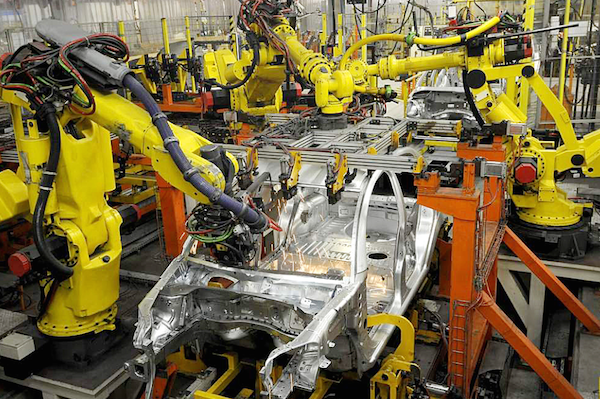A major worry in these parts has been the lack of automation awareness in the Trump administration. The last statement I can recall was in 2017 when Treasury Secretary Steve Mnuchin remarked, “It’s not even on our radar screen. . . 50-100 more years.” The tech world exploded at that ignorance, reported here: Treasury Secretary Blunder Sparks Discussion of Automated Future.
Below, human workers have largely disappeared from areas of automotive manufacturing since robots came on line.
![https://www.limitstogrowth.org/ltg-uploads/2017/04/YellowRobotsWeldingCar.png]()
So it was good news to see the president sign a forward-looking document that recognizes the revolutionary changes that technology is creating in the economy and workplace. The article linked below gripes about the lack of funding, but any White House awareness of the automated future is a big plus compared with what we have seen so far.
Trump signs executive order to spur US investment in artificial intelligence, TheVerge.com, By James Vincent, Feb 11, 2019
The new American AI Initiative will be a shot in the arm for the industry, but it’s vague and includes no new funding
America may be the current world leader in artificial intelligence, but its place is anything but assured. While nations around the world have launched programs to stimulate AI development, the Trump administration has practically ignored the topic. That changed today, when President Tump signed an executive order creating the “American AI Initiative” — a high-level strategy guiding AI development within the US.
The initiative will redirect federal funding and resources towards AI research, as well as call for the creation of US-led international standards in AI, and new research into the retraining of American workers. But the program includes no new funding for AI development, and is thin on details. The administration is not sharing any timelines for reaching its stated goals, and is instead promising a more detailed plan some time in the coming six months.
“Americans have profited tremendously from being the early developers and international leaders in AI,” reads the White House press release. “However, as the pace of AI innovation increases around the world, we cannot sit idly by and presume that our leadership is guaranteed. We must ensure that advances in AI remain fueled by American ingenuity, reflect American values, and are applied for the benefit of the American people.”
According to the Trump administration, the goals of the AI Initiative are split into five key areas:
• Research and development. Federal agencies will be asked to “prioritize AI investments” in their R&D budgets, and report how this money is spent to create a more comprehensive overview of government investment in artificial intelligence.
• Freeing resources. Federal data, algorithms, and processing power will be made available to researchers, providing a boost in areas like transportation and health care.
• Ethical standards. Government bodies like the White House Office of Science and Technology Policy and the National Institute of Standards and Technology (NIST) will be asked to create standards that will guide the development of “reliable, robust, trustworthy, secure, portable, and interoperable AI systems.”
• Automation. Agencies will be asked to prepare workers for changes to the job market caused by new technology with the creation of fellowships and apprenticeships.
• International outreach. The administration wants to work with other countries on AI development, but do so in a way that retains American “values and interests.”
The initiative addresses a number of areas of key concern in AI development, but the lack of new funding will worry some. To date, 18 countries have launched national AI strategies, and half of these include new sources of funding. Figures range from roughly $20 million in Australia and Denmark to nearly $2 billion in South Korea.
Notably, the new program fails to address the issue of immigration. America’s lead in AI is partly due to its ability to attract foreign talent, but experts warn that researchers are increasingly put off by the Trump administration’s anti-immigrant rhetoric and its promises to restrict visa freedoms. According to statistics from the National Science Foundation, the number of overseas grad students in the US fell by 5.5 percent between 2016 and 2017. . .
That last paragraph shows enormous ignorance of immigration policy: Trump objects to illegal aliens; in the SOTU he said he wanted an increase in immigrant workers. Plus, America is already friendly toward tech innovation and doesn’t need foreign workers — particularly the many thousands of Red Chinese who come to steal US technology secrets.













